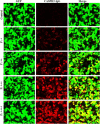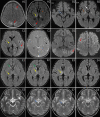CASPR2 antibody associated neurological syndromes in children
- PMID: 36747031
- PMCID: PMC9902610
- DOI: 10.1038/s41598-023-28268-x
CASPR2 antibody associated neurological syndromes in children
Abstract
To strengthen the understanding of the clinical features for CASPR2 neurological autoimmunity in children. A multicenter retrospective and prospective analysis of CASPR2 autoimmunity was conducted. Twenty-six patients were enrolled, including 25 with serum positivity and 3 with cerebrospinal fluid (CSF) positivity; 5 patients were co-positive with anti-NMDAR or anti-GABABR antibodies. Eleven patients (who manifested with refractory epilepsy, psychobehavioral abnormalities or germinoma) presented with low antibody titers, relatively normal MRI/EEG/CSF examinations, and poor response to immunotherapy and were thus considered false positive (42.3%). Fifteen patients were diagnosed with autoimmune encephalitis/ encephalopathy/ cerebellitis (including 1 whose condition was secondary to Japanese encephalitis). The most common symptoms included disorders of consciousness (10/15), fever (8/15), psychological symptoms/abnormal behaviors (8/15), sleep disorders (8/15), seizures (7/15), movement disorders (5/15), autonomic symptoms (5/15). Brain MRI revealed abnormalities in 10 patients (66.7%). Electroencephalography (EEG) recordings revealed a slow wave background in 13 patients (86.7%). Five patients showed elevated WBCs in CSF, and 4 patients showed elevated protein levels in the CSF. Thirteen patients received immunotherapy (rituximab was adopted in 2 cases) and recovered well. Two patients received symptomatic treatment, and the recovery was slow and accompanied by emotional abnormalities and developmental delay. Autoimmune encephalitis is the most common clinical phenotype; it can be secondary to Japanese encephalitis. Rituximab can be used in patients who respond poorly to conventional immunotherapy. The high false-positive rate of anti-CASPR2 in refractory epilepsy and the psychobehavioral abnormalities needs to be explored further.
© 2023. The Author(s).
Conflict of interest statement
The authors declare no competing interests.
Figures



References
-
- Joubert B, Saint-Martin M, Noraz N, et al. Characterization of a subtype of autoimmune encephalitis with anti-contactin-associated protein-like 2 antibodies in the cerebrospinal fluid, prominent limbic symptoms, and seizures. JAMA Neurol. 2016;73(9):1115–1124. doi: 10.1001/jamaneurol.2016.1585. - DOI - PubMed
Publication types
MeSH terms
Substances
Supplementary concepts
LinkOut - more resources
Full Text Sources
Medical

